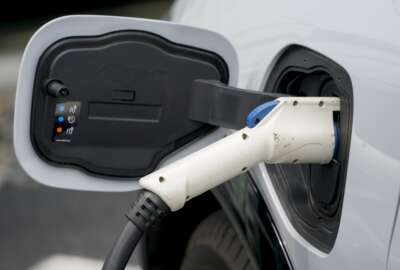The Navy conducted its first-ever climate change-focused wargaming exercise Wednesday, ushering in a new area of contingencies for the military as its operations continue to be exponentially impacted by extreme weather.
The service brought together high-ranking Navy officials, enlisted sailors, think tank experts, non-governmental organizations, industry and legislative aides to participate in a tabletop exercise focused on responding to a climate event.
The exercise signals the increasing importance of climate change factors on how the military operates and plans for the future.
The situation involved a fictional scenario in late 2030 where the Navy is conducting an amphibious exercise on an island nation in the western Pacific. A typhoon forms, changes course and heads directly for the exercise.
“We had our groups built into three breakout groups that were related and dealing with that the same impacts in different ways at different times,” Meredith Berger, Navy assistant secretary for energy, installations and environment, told reporters during a roundtable. “They were faced with dilemmas. They had to work together as a team to make sure that they could answer questions and try to understand the practical operational applications.”
Berger said the exercise was an opportunity for the Navy to address some of the “very real” impacts that it knows are coming as a result of climate change. She said one of the key takeaways from the training is that the Navy cannot allow climate contingencies to become a surprise. The Navy must develop flexibility to address the issues that will arise from the new threat.
“Another lesson is tied to logistics,” Berger said. “The more that we can reduce those dependencies, the more that we can diversify where we do have dependencies the better we are set up for success. It is important that we think about redundancy and everything that we are doing to be more effective to safeguard against those types of failures. It goes back to the planning and it shows that we’re on the right course, that we are anticipating, that we are thinking about how to be efficient, how to be effective, how to make sure that we are sharing burdens and sharing opportunities to be effective warfighters.”
The Defense Department is also thinking about these issues by reinforcing its supply chain and considering adding to its emergency stockpiles.
The Navy’s top energy official said during the exercise sailors saw severe impacts from the typhoon that caused them to think about things like keeping ships in line during a storm, what to do when communication goes down and taking alternative plans of action.
Berger said the Navy is planning to build climate contingencies into other exercises and to start conducting more exercises specifically tailored to climate change.
The Navy and the military writ large have been putting increasing focus on climate change. That means making installations and weapons more resilient, figuring out how to operate in extreme weather and decreasing the military’s impact on the environment.
In May, the Navy released its climate action 2030 plan. The service has developed its strategy around DoD’s five lines of effort on climate change. Those include things like climate-informed decision making, where Navy leaders train for situations of extreme weather, and supply chain resilience, in which the Navy invests in companies that support national security and climate benefits.
Last October, the Pentagon took its largest step yet to become more climate conscious by releasing its climate adaptation strategy. DoD announced it will create a climate chief and stated that it will consider climate in every decision it makes from now on.
Copyright
© 2024 Federal News Network. All rights reserved. This website is not intended for users located within the European Economic Area.
